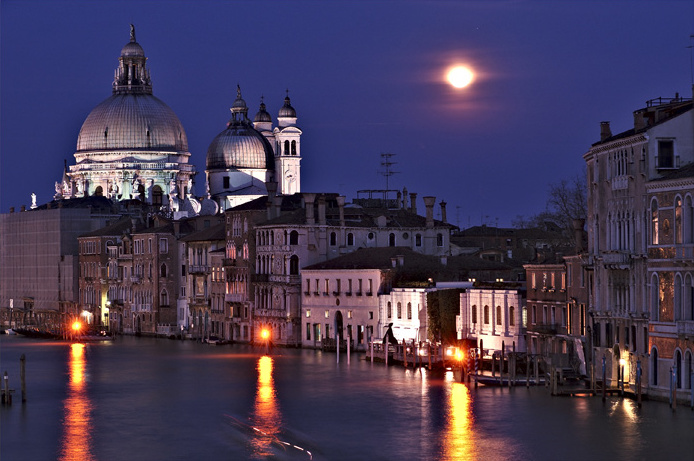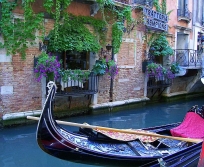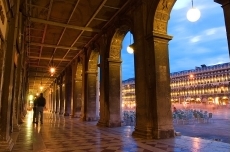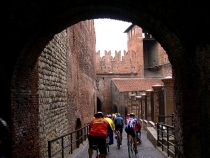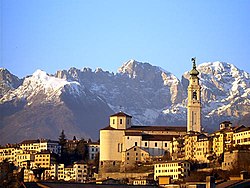Veneto
Template:Infobox Region of Italy
Veneto or Venetia, is one of the 20 regions of Italy. Its population exceeds 4.7 million, and its capital is Venice. Once the cradle of the renowned Venetian Republic, then a land of mass emigration, Veneto is today among the wealthiest and most industrialized regions of Italy. Veneto's natural, historical, and artistic beauty makes it, by far, the most visited region of Italy, with about 13.5 million tourists every year (2006)[1]. Spoken languages are Italian, Ladin and Venetian (a motion to recognize Venetian as an official regional language has been approved by the regional Parliament[2]). The Regional Constitution, approved by the Italian Parliament in 1971, also recognizes Veneto inhabitants as a "people" ("popolo" in Italian)[3].
Geography
Veneto is located in the northeastern part of Italy, bordering on the Italian regions of Emilia-Romagna and Lombardy, the autonomous Italian regions of Trentino-Alto Adige/Südtirol and Friuli Venezia Giulia, and the nation of Austria. It lies between the Alps and the Adriatic Sea and is crossed by the rivers Po, Adige, Brenta and Piave.
Provinces

The Veneto itself is subdivided into seven provinces:
History
The Venetic Period
Between the 2nd and 1st millennia B.C., the region was inhabited by the Euganei. According to ancient historians, the Veneti (sometimes called the Paleo-Veneti), came from the Balkans at the time of the Fall of Troy, led by prince Antenor, a comrade of Aeneas. In the 7th-6th centuries B.C. the local populations of Veneto entered into contact with the Etruscans and the Greeks. Venetic culture reached a highpoint during the 4th century B.C. These ancient Veneti spoke Venetic, an Indo-European language akin to, but distinct from Latin and the other Italic languages. Meanwhile, the Veneti propsered through their trade in amber which they acquired from the Baltic and were well-known for their breeding of horses. Este, Padua, Oderzo, Adria, Vicenza, Verona, and Altino became centers of Venetic culture. However, over time, the Veneti began to adopt the dress and certain other customs of their Celtic neighbors.
The Roman Period
During the third century B.C., the Veneti, together with the Cenomani Celts on their western border, sided with the Romans as Rome expanded and struggled against the Insubri and Boi Celts. During the Second Punic War (218 B.C. – 202 B.C.), the Veneti even sent a contingent of soldiers to fight alongside the Romans against Hannibal and the invading Carthaginians and Veneti were among those slaughtered at the Battle of Cannae (216 B.C.). In 181 B.C., a Roman triumvirate of Publius Scipio Nasica, Caius Flaminius, and Lucius Manlius Acidinus led three thousand families, mainly from Samnium but supplemented by native Veneti, to found a Latin colony at Aquileia as a base to protect the territory of the Veneti from incursions of the hostile Carni and Istri. From then on, Roman influence over the area increased. Thus, in 169 B.C. more colonizing families were sent from Rome to Aquileia. In 148 B.C. the Via Postumia was completed connecting Aquileia to Genua. In 131 B.C., the Via Annia joined Adria to Patavium to Altinum to Concordia to Aquileia. Gradually, the Roman Republic transformed its alliance with the Veneti into a relationship of dominance. After the 91 B.C. Italic rebellion, the cities of the Veneti, together with the rest of Transpadania, were granted partial rights of Roman citizenship according to the Lex Pompeia Transpadanis. Later in 49 B.C., by the Lex Rubria de Gallia Rome granted full Roman citizenship to the Veneti. Such citizens would have benefitted from the Via Claudia completed in 46 B.C. and connecting Altinum to Tarvisium to Feltria to Tridentum (modern Trento). [From Tridentum it continued north to Pons Drusus and south through Verona to Mutina (modern Modena).] After the Battle of Philippi (42 B.C.), which ended the Roman Civil War, the lands of the Veneti, together with the rest of Cisalpine Gaul, ceased to be a province and the territory of the Veneti, which included modern Friuli, became region X (Venetia et Istria) of a new entity named Italia (Italy). Aquileia became its capital. Meanwhile, under the Pax Romana, Patavium (modern Padua) became one of the most important cities of northern Italy. Other Venetic cities such as Opitergium (modern Oderzo), Tarvisium (modern Treviso), Feltria (modern Feltre), Vicetia (modern Vicenza), Ateste (modern Este), and Altinum (modern Altino) prospered and Romanized adopting the Latin language and Roman culture. Thus, by the end of the first century A.D., Latin had finally displaced the Venetic language.
The Middle Ages
Already in 166 A.D., the Quadi and Marcomanni had briefly invaded Venetia. In the fifth century, both Alaric the Goth and then Attila and the Huns devastated the area. Attila laid siege to Aquileia and turned it into a ruin in 452 A.D. Many of the mainland inhabitants sought protection in the nearby lagoons which would become Grado in the east and Venice more to the west. On the heels of the Huns came the Ostrogoths who not only invaded, but settled the land. During the mid-sixth century, Justinian reconquered Venetia for the Eastern Roman Empire. An Exarch was established at Ravenna while a military tribune was set up in Oderzo. Byzantine rule would not last long. Starting in 568 A.D, the Lombards crossed the Julian Alps. These invaders subdivided the territory of Venetia into numerous feuds ruled by Germanic dukes and counts (essentially creating the division of Veneto from Friuli). The invasion provoked another wave of migration from the mainland to the Byzantine controlled coast and islands. In 667, A.D. the Lombards conquered the Byzantine base at Oderzo and took possession of practically all of Veneto (and Friuli) except for Venice and Grado. The 36 Lombard duchies included Ceneda, Treviso, Verona, and Vicenza, and within the Veneto itself, a reminder of Lombard hegemony is seen today in palace names which begin with the word "Farra." By the middle of the eight century, the Franks had assumed political control and mainland Veneto became part of the Carolingian Empire. Though politically dominant these Germanic invaders were gradually absorbed into the Venetian population over the centuries. In the late ninth century, Berengar, Margrave of the March of Friuli was elected king of Italy. Under his turmultuous reign, the March of Friuli was absordbed into the March of Verona so that Verona's territory contained a large portion of Roman Venetia. In the tenth century mainland Veneto, after suffering invasions from nearby Magyars and Slavs, was incorporated into the Holy Roman Empire. Gradually, the communes of the mainland grew in power and wealth. In 1167 an alliance (called the Lombard League) was formed among the Venetian cities such as Venice, Padua, Treviso, Vicenza, and Verona with other cities of Northern Italy to assert their rights against the Holy Roman Emperor. The Second Treaty of Constance in 1183 confirmed the Peace of Venice of 1177 in which the cities agreed to remain part of the Empire as long as their jurisdiction over their own territories was not infringed upon. The league dissolved at the death of Emperor Frederick II in 1250. The period also witnessed the founding of the second oldest university in Italy, the University of Padua founded in 1222. Around this time, Padua also served as home to St. Anthony, the beloved saint called simply "il santo" ("the saint") by the inhabitants of the town.
The Serenissima: The Republic of Venice
As the barbarians were interested in the wealth of the mainland, part of the Venetian population sought refuge on some of the isolated and unoccupied islands of lagoon, from which the city of Venetiae or Venice was born. After a period of Byzantine domination in 8th century, Venice became an independent maritime Republic ruled by its elected dux or doge.
The Republic proved to be a commercial superpower, and its influence lasted through the Middle Ages and the Renaissance. In fact, the Venetian Republic enjoyed 1100 years of uninterrupted influence throughout the Mediterranean. By the 16th century, Venetian Republic held dominion over Veneto, Friuli, part of Lombardy and Romagna, Istria, Dalmatia, the Ionian Islands of Corfu, Cefalonia, Ithaca and Zante. From the 13th to 17th centuries it held the island of Crete and from the mid-15th to mid-16th century, the island of Cyprus. Venetian mainland holdings led to Venetian involvement in European and in particular, Italian politics. Cities had to be fortified, one impressive example being Palmanova in Friuli. However, the wise rule and propserity brought by the Serenissima made the cities of the terra firma willing subjects. Eastern Islands served as useful ports for Venetian shipping. However, as the Ottoman Empire grew more powerful and aggressive, Venice was often put on the defensive. Ottoman control of the eastern Mediterranean and the discoveries of sea routes to Asia around Africa and of the Americas had a debilitating effect on the Venetian economy.
See also:
The French and Austro-Hungarian Periods
In 1797, Napoleon invaded the territory of the Venetian Republic. Overwhelmed by more powerful forces, Doge Ludovico Manin resigned and retired to his villa at Passariano in Friuli and the thousand year old Republic disappeared as an independent state. This proved very unpopular in the mainland cities where sympathies were strongly with the Republic of Venice. In many places peasants actively attempted to resist the French invaders who arrogantly claimed to bring them liberty. By the Treaty of Campoformio signed on October 17, 1797 part of the mainland Venetian territory was handed over to the Austrian Empire and a western part was annexed to the Cisalpine Republic. The territory soon reverted back to Napoleon in 1801, but after his defeat it was handed over to Austria again. The Veneto remained in Austrian hands, except certain cities briefly in 1848, until annexed by the Kingdom of Italy.
The Italian Period
In 1866 after the Third War of Independence the Veneto was annexed. After a controversial referendum, it was occupied by Italian troops, the Carabinieri. In an effort to "italianize" the population, the dialects of Venetian were forbidden while often people's surnames and place names were changed.
Because of the conditions brought about by the new Italian government, the 19th century became a period of emigration. Hundreds of thousands Venetians made the difficult decision to abandon their native land and homes and seek more congenial circumstances in Rio Grande do Sul, Brazil; Chipilo, Mexico; other parts of South America; Australia, Canada, and the United States of America. In many of these places their descendants have maintained the use of their respective ancestral Venetian dialect.
The First World War began shortly after the Venetian pope, St. Pius X died. After Italy entered the War, the Veneto became a major front. The flooding of the Piave River would play a major role in the Italian victory at the Battle of Vittorio Veneto which was fought between October 24 and November 3 1918 and serve as the major turning point in the War.
After the Second World War, the Venetian spirit of sacrifice and a family orientation played a major role in an economic recovery that harmoniously blended traditional agriculture, trade, and industry.
Economy
After the destruction and bombardments by the Allied forces in Second World War the Veneto region became one of the poorest places in Italy. Nevertheless, in short time, things began to turn around. Today, the Veneto, although to a large degree agricultural, is one of the most industrialized regions of Italy, with high annual economic growth and a very dynamic economy. Some Italian newspapers have called this industrialization "The Nord-Est Miracle", due to the economic boom during the last decade of the 20th century. During the last decade of the 20th century, a large number of Venetian industries opened some branches in Eastern European countries such as Romania, Bulgaria, Hungary and the Czech Republic. The Romanian city of Timişoara is also known as "The Newest Venetian Province", due to the high presence of Venetian industries.[citation needed]
Agriculture
The agriculture of the region has witnessed significant progress during the past 20-30 years. The territory of Veneto is still dominated by small landholdings and agriculture is mixed. The other phenomenon is part-time work in the agricultural sector; after the working-day on a factory, people cultivate their private pieces of land. The principal agricultural products include maize, green peas, vegetables, apples, cherries, sugar beets, forage, tobacco, hemp. Significant production of grapes occurs in hilly zones, leading to the creation of well-regarded wines. The region also has extensive cattle-raising and fishing.
Industry
Thanks to ancient traditional artisan activities industry takes its origins from the past century in some pre-Alpine valleys. In the last 30-40 years industrialization transformed the appearance of the landscape, especially in the plains, where hundreds of industrial complexes were built. Metallurgical and chemical plants were built in Marghera and Mestre. In other parts of the region were affirmed little and medium activities in various sectors: food, textiles, chemistry, metal-mechanics, glass, electronics, eyeglasses (exported). Artisan production is also quite strong: Murano glass, laces of Burano and gold production of Vicenza. Apart from agriculture and industry activities such as commerce, banking and tourism are also important. In province of Belluno there is the more important area of the world for the production of glances at them (Luxottica, Safilo, Marcolin ecc.).
politics are crap shove a dick up there ass
Demographics
A land of emigration until the 1970s, the Veneto has come to attract an influx of foreign immigrants since the economic industrial boom of the 1980s. As of 2006, the Italian national institute of statistics ISTAT estimated that 320,793 foreign-born immigrants live in Veneto, equal to 6.7% of the total regional population.
Religion
Christianity entered the region very early on. The region venerates the second century bishop St. Hermagoras and his deacon St. Fortunatus, both of Aquileia and both marytrs, as patrons. Aquileia became the metropolitan see of Venetia. Aquileia had its own liturgical rites which were used throughout the dioceses of the Veneto until the later Middle Ages when the Roman Rite replaced the Aquileian Rite.
As of 2004, over 95% of the population claimed to be Roman Catholic. The region of the Veneto along with the regions of the Friuli and Trentino-Alto Adige/Südtirol form the ecclesiastical region of Triveneto under the Patriarchate of Venice. The Patriarchate of Venice is an archdiocese and metroplitan see of an ecclesiastical province which includes suffragan episcopal sees of Adria-Rovigo, Belluno-Feltre, Chioggia, Concordia-Pordenone, Padua, Treviso, Verona, Vicenza, and Vittorio Veneto.[4] The Archdiocese of Venice was elevated to a honorary Patriarchate by the pope on October 8, 1457 when the Patriarchate of Grado was suppressed. The saintly first patriarch of Venice was Laurence, a nobleman of the Giustiniani family. During the twentieth century the patriarch was often also named a cardinal, and three cardinal patriarchs, Giuseppe Sarto, Angelo Roncalli, and Albino Luciani were elected popes Pius X, John XXIII, and John Paul I, respectively. The Patriarchate of Venice claims St. Mark the Evangelist as its patron. His symbol of the winged lion became a typical symbol of the Venetian Republic.
Language
Most of the people of the Veneto speak standard Italian. However, there is widespread usage of the various local dialects of Venetian. Each of the Venetian dialects derive from the Latin as spoken by the Veneti with words borrowed from Germanic invaders. The Venetian dialects are classified as an Italo-Western Romance language. Variants include an Eastern/Coastal (Venice), a Central type (Padua, Vicenza, Polesine), Western (Verona), North-Central (Treviso), and Northern (Belluno, Feltre, Agordo, Cadore, Zoldo Alto). Each is mutually intelligble to varying degrees. Ladin is spoken in parts of the province of Belluno.
Culture
Veneti are very proud of their culture. Each section of the various towns has its patron saint whose feast day is celebrated. Many other festivals are closely allied to the religious calendar. Among these:
- Panevin celebrated around Epiphany;
- Carneval celebrated the Tuesday before Ash Wednesday;
- Pasqua (Easter Sunday);
- Saint Mark's feast day (April 25);
- La Sensa (Ascension Thursday);
- San Giovanni Battista (June 24);
- La festa del Redentor (mid July);
- Vendemmiare (grape harvest in September);
- San Nicolò de Bari (St. Nicholas, December 6);
- Nadal (Christmas).
Climate
The variations in climate are influenced by the particular morphology. Continental on the plains, the climate is milder along the Adriatic coast, around Lake Garda and in the open hilly areas. Winters are often harsh everywhere due to northeasterly winds: in the mountains, temperatures can be very low, as low as -35/-30°C in places like Marcesina, 1500m, near Asiago, or Cansiglio in Belluno area, 900m; the coastline, with Venice and just to a few kilometers from the sea, is slitghtly milder than the inner plain, but often covered by thick fog as the central and southern plain; snow is usually abundant in the mountains, where on the highest pikes it may fall even during mid summer, less frequent but not unusual at plain. Precipitation is scarce (750 mm. /year) on the lower plain, especially near river Po, more abundant (750-1,100 mm./year) on the upper plain; the highest values (up to 3,200 mm./year) are recorded in the Bellunese Prealps, near Pasubio and on the Asiago plateau.
Main tourist attractions
The Veneto region ranks first in the tourist sector in Europe, with about 60 million tourists every year.
The cities of art
Venice: The kaleidoscopic scenario born of an amazing, intricate and harmonious communication network of water and stone casts light and shadows unique in the world upon a city already singular for its art, history and culture. Venice and its lagoon are listed as World Heritage Sites by UNESCO.
Verona: The city of the most famous lovers in history: Romeo and Juliet.It is one of the cities that has better preserved its artistic heritage in Italy. Verona has been named a UNESCO world heritage site.

 File:Padua 3.jpg File:Padua 4.jpg
File:Padua 3.jpg File:Padua 4.jpg
Padua: also known as the City of the Saint, is a city of huge importance for its cultural, historical and economic aspects and the Orto botanico di Padova is on UNESCO's list of World Heritage Sites.
File:Vicenza 1.jpg  File:Vicenza 3.jpg
File:Vicenza 3.jpg
Vicenza is on UNESCO's list of World Heritage Sites, together with a number of the Palladian Villas.
Belluno the capital of the Dolomites, the bells tower by the architect Filippo Juvarra
Montagnana is a commune in the province of Padova with great famous perfectly conserved medieval walls
Bassano del Grappa with its wooden covered bridge or Ponte degli Alpini on the river Brenta, designed in 1569 by the architect Andrea Palladio
Marostica : The 'Chess Game' event takes place on the second weekend of September and it involves over 550 characters and lasts two hours.
Asolo is known as 'The Pearl of province of Treviso', and also as 'The City of a Hundred Horizons'.
Este : The House of Este held the city until 1240, when they moved their capital to Ferrara.
Ville Venete
File:La Rotonda little.jpg File:Villa cornaro.jpg 
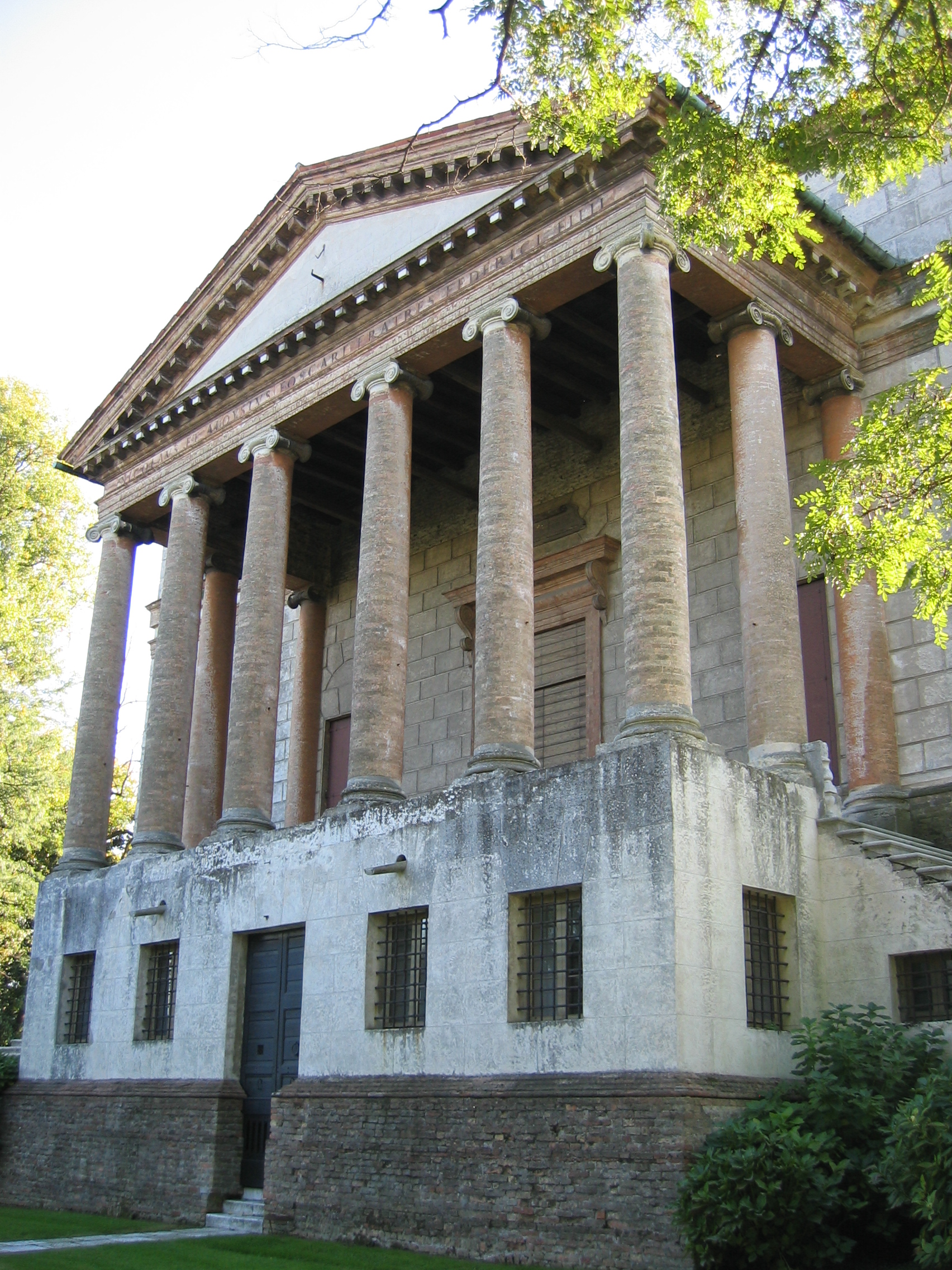
All over the Venetian plain, but especially in the Provinces of Treviso, Padua, Vicenza and Venice, there stand numerous remarkable artistic rural constructions, the Ville Venete. The dates of construction of these villas range from the fifteenth to the nineteenth centuries. There are approximately five thousand Ville Venete, of which 1,400 are declared of historical and monumental interest.
- CISA : The Centro Internazionale di Studi di Architettura Andrea Palladio (Palladio Centre and Museum) in Vicenza is an independent Foundation, supported by the Veneto Regional Government and by the Italian state
Parks
Cansiglio is a pre-alpine massif located in the northeastern Veneto within the provinces of Treviso and Belluno.
Parco Nazionale Dolomiti Bellunesi is situated in the southern section of the Province of Belluno, it has beautiful landscapes, waters, woods typical of Dolomites.
Link: [Official Web Site]
Lakes

Lake Garda has boasted of a mild climate and a Mediterranean-type environment since the days of Pliny and Catullus. The area is a major tourist destination. Various towns along the lake, such as Lazise, Cisano, Bardolino, Garda (VR), Torri del Benaco and Malcesine, have become resorts.
Mountains
|
Cortina d'Ampezzo, it's situated in the Belluno's province, is probably among the three most exclusive mountain locations in Europe and it is well-known for its first-class hotels and shops. It was host to the 1956 Winter Olympics. Many travel to Cortina for winter sports. Just north is the Tre Cime di Lavaredo said to be a symbol of the Italian Dolomites.[5] |
|
Arabba lies between the Sella group and the Marmolada. |
|
Sappada is in the extreme north of the region. |
Rivers
The most important rivers of the Veneto are the Piave (sacred river), the Brenta, the Bacchiglione, the Livenza, the Po, and the Adige. Smaller rivers include the Meschio and the Sile.
Thermal bath
The thermal baths at Abano Terme are also an attraction. Although the most famous, Abano is by no means the only thermal town in the area. It is however one of the prettiest and most tranquil.
Beaches
Venice's Lido is an 11-mile long sandbar, home to about 20,000 residents, greatly augmented by the (mainly Italian) tourists who move in every summer.
Jesolo is one of the most important seaside resort on the Adriatic coast, just few kilometers far from Venice. With a sandy beach more than 13km long, Jesolo is one of the longest beaches in Italy. Every year Jesolo accommodates over 4.5 million tourists.
Caorle: it is extremely pleasant to spend some time swimming in Caorle’s beautiful blue sea or sunbathing in its golden beaches, often awarded for being one of the cleanest beaches in Italy.
Bibione The clear and gentle Adriatic Sea, offer to Bibione a wide beach of golden sand. It is 10 km long, Bibione is also an important and fully equipped thermal resort
Eraclea is a small and tranquil paradise right in the middle of pine forests.
Food and wines
There are some fine wines from the Veneto region of Italy, these include: Soave, Bardolino, Recioto, Amarone, Torcolato, Prosecco, Tocai Rosso,Garganega, and Valpolicella. Other common wines include Verduzzo, Raboso, Moscat, Cabernet Franc, Pinot Nero, Pinot Grigio, and Merlot. Homemade wine making is widespread. From the pressed grapes grappa is made.
See also: Wines of Veneto and Wineries in the Veneto
Among the well-known cheeses of the Veneto are: Asiago (PDO) (from Asiago), Monte Veronese (PDO), Piave (PDO), Morlacco, Grana Padano (PDO).
Garda and Veneto olive oils (PDO) are other remarkable products of this region.
Fresh & cured meats
The Sopressa Vicentina (PDO) is an aged salami, cylindrical in shape and prepared with raw, quality pork meat. It may or may not include garlic in its ingredients and comes in medium and large sizes.
Prosciutto Veneto Berico-Euganeo (PDO) is obtained from the fresh meat of a top breed of adult hogs. The aroma is delicate, sweet and fragrant.
Cereals, vegetables & fruits
Radicchio Rosso di Treviso (PGI) is a peculiar vegetable with a faintly bitter taste and a crunchy texture. The production area encompasses many town districts in the provinces of Treviso, Padua and Venice.
The Radicchio Variegato di Castelfranco (PGI) has a delicate and slightly sweet taste and a crunchy texture.
Veronese Vialone Nano Rice from Verona (PGI) : a white rice with short, plump grains, which have a creamy consistency when cooked. They are commonly used in risotto dishes and have a high starch content.
The Bean of Lamon (PGI) type is particularly prized for its delicate flavour and extremely tender skin.
The White Asparagus of Cimadolmo (PGI) has a characteristic scent and a very delicate taste.
The White Asparagus of Bassano is a delight of northern Vicentino, is a shoot which has not yet broken the earth and owes its characteristic whiteness to its brief underground existence.
The S.Zeno di Montagna (Verona) chestnut (PDO) with its sweet taste.
Cerries of Marostica (PGI) in those the pulp varies in consistency from crisp to soft and the flavour is finely graded from sour to sweet.
Miscellaneous
According to Robert Putnam,[4] the "institutional performance" of Veneto's regional government is higher than average in Italy, thus Veneto belongs to what Putnam defines as "civic North". Veneto has a long tradition of high quality public health care, which can be traced to the historical heritage of the Republic of Venice.
Veneto hosts one of the oldest universities in the world at Padua, which is the second oldest one in Italy after Bologna. OECD investigations[5] show that school education achievements in North-Eastern Italy (whose population comes mainly from Veneto) are highest in Italy and comparable to France and Sweden.
Veneto is also the name of the main battleship class which Italian navy possessed during World War II. The Veneto class battleship includes Vittorio Veneto and Rome. Both ships were damaged in the famous Taranto raid of the British Royal navy and participated in most of the major sea battles between Britain and Italy in the Mediterranean.
Notable people from the Veneto
- Caius Volteius Capito (born ? Oderzo - died ?), centurion who fought with Julius Caesar in the Roman Civil War against Pompey.
- Marcus Vitruvius Pollio (ca. 80/70 BC Venetia? - ca. 25 BC) was a Roman writer, soldier, architect, and engineer.
- Titus Livius known as Livy in English (ca. 59 BC at Padua - 17AD ) wrote a monumental history of Rome, Ab Urbe Condita, from its founding (traditionally dated to 753 BC) through the reign of Augustus.
- Gaius Valerius Catullus (ca. 84 BC Verona - ca. 54 BC Rome), one of the most influential Roman poets of the 1st century BC.
- Publius Clodius Thraseus Paetus (born ? Padua - died AD 66), Roman Senator and Stoic philosopher who protested the abuses of and was subsequnetly killed by order of Nero.
- Totila (early 6th c. AD, Treviso - 552Taginae), King of the Ostrogoths, military genious, killed by forces of Justinian at Battle of Taginae
- Venantius Honorius Clementianus Fortunatus (ca. 530 - 540 near Valdobbiadene - ca. 609 Poitiers) Latin poet and hymnodist, bishop of Poitiers (600 - 609).
- Enrico Dandolo (ca.1107–1205), Doge of Venice from 1192 until his death; although aged, blind, and excommunicated, he led the forces which conquered Constantinople.
- Marco Polo (September 15 1254 Venice - January 8, 1324 Venice) was a Venetian merchant and explorer of Persia, India, and China who wrote of his travels.
- Benedict XI born "Nicholas Boccasini" (1240 Treviso – July 7, 1304 Rome), pope from 1303 to 1304.
- Gregory XII born "Angelo Correr", in Venice, died (October 18, 1417 Rome), pope from 1406 to 1415 during the Great Western Schism.
- Eugene IV born "Gabriele Condulmer" (1383 Venice – February 23, 1447 Rome), pope from March 3, 1431 to February 23, 1447.
- Paul II born "Pietro Barbo" (1417 Venice - 1471 Rome), pope from August 30, 1464 to July 26, 1471.
- Panfilo Castaldi (1398 Belluno - 1479 Venice?), switched from study of medicine to typography, considered a precursor to Guttenburg.
- Andrea Mantegna (c. 1431,Isola di Carturo now Isola Mantegna (Padova), Italy – September 13, 1506, Mantua) was the first truly Renaissance artist of Northern Italy.
- Giovanni Caboto a.k.a. John Cabot (c. 1450 (Genova) – c. 1499), navigator and explorer credited as the first early modern European to discover the North American mainland in 1497; a citizen of the Republic of Venice.
- Pietro Bembo (1470 Venice - 1547 Rome), Venetian patrician, historian of the Republic, Renaissance poet and humanist, named cardinal by Pope Paul III in 1539.
- Sebastiano Caboto (1477 Venice - 1577 London) explorer for Spain and England, son of John Cabot.
- Giorgione (c. 1477–1510) is the familiar name of Giorgio Barbarelli da Castelfranco, one of the seminal artists of the High Renaissance in Venice.
- Titian or Tiziano Vecellio (c. 1488/1490 – August 27, 1576) was the leader of the 16th-century Venetian school of the Italian Renaissance.
- Marcantonio Flaminio (1498 Serravalle - 1550) Renaissance Humanist and secretary to Cardinal Pole at the Council of Trent
- Angelo Beolco a.k.a. "il Ruzzante" or "el Ruzante" (1502 Padua – 1542), actor and playwright who wrote in the dialect of Padua.
- Andrea Palladio (November 30, 1508 Padua – August 19, 1580 Maser) was an Venetian architect, widely considered the most influential person in the history of Western architecture.
- Andrea Gabrieli (c. 1510 (Venice) – late 1586 (Venice)) was late Renaissance composer and organist, the first internationally renowned member of the Venetian School of composers who spread the Venetian style in Italy as well as in Germany.
- Tintoretto (real name Jacopo Robusti; 1518 - May 31, 1594) was one of the greatest painters of the Venetian school and probably the last great painter of Italian Renaissance.
- Giovanni Gabrieli (c.1554–1557 (Venice) – August 12, 1612 (Venice)), composer and organist whose works represent best of the of the Venetian School; nephew of Andrea Gabrieli.
- Alexander VIII born "Pietro Vito Ottoboni" (April 22, 1610 Venice – February 1, 1691 Rome) was pope from 1689 to 1691.
- Francesco Morosini (1618 Venice - 1694 Nauplia), Doge of Venice, called "il Peloponnesiaco" for his reconquest of Greece and defense of it against the Ottoman Turks.
- Marco d'Aviano (1631 Aviano, Republic of Venice - 1699) was Capuchin friar, papal legate to the "Holy League", and purported inventor of cappuccino; beatified in 2003.
- Benedetto Marcello (born July 31 or August 1, 1686 in Venice - died July 24, 1739 in Brescia) was a composer, writer, advocate, magistrate, and teacher.
- Antonio Vivaldi (March 4, 1678, Venice – July 28 (or 27), 1741, Vienna), nicknamed Il Prete Rosso ("The Red Priest") was a priest and baroque music composer, as well as a famous violinist.
- Clement XIII born "Carlo della Torre Rezzonico", (March 7, 1693 Venice – February 2, 1769 Rome), pope July 6, 1758 to February 2, 1769.
- Carlo Goldoni (February 25, 1707 - February 6, 1793), Along with Luigi Pirandello, Goldoni is probably the most famous name in Italian theatre, in his country and abroad.
- Giovanni Battista Piranesi (October 4, 1720 in Mogliano Veneto (near Treviso) - 9 November 1778 in Rome) was famous for his etchings of Rome and of fictitious and atmospheric "prisons" (Carceri d'Invenzione).
- Giacomo Casanova (aka Jacques Casanova) (April 2, 1725 Venice - June 4, 1798 Dux, Bohemia (now Duchcov, Czech Republic)), infamous Venetian adventurer, writer, and womanizer.
- Ludovico Manin (May 14, 1725 – October 24, 1802), last Doge of Venice.
- Lorenzo Da Ponte born "Emmanuele Conegliano,"(March 10, 1749 Ceneda (Vittorio Veneto) – August 17, 1838 New York), librettist to Mozart, first professor of Italian language and literature at Columbia College, helped establish an Opera House in Manhattan.
- Antonio Salieri (August 18, 1750 Legnago (Province of Verona) – May 7, 1825), composer and conductor who became the Austrian imperial kapellmeister from 1788 to 1824.
- Antonio Canova (November 1, 1757 - October 13, 1822) was an sculptor who became famous for his marble sculptures that delicately rendered nude flesh.
- Gregory XVI born "Bartolomeo Alberto Cappellari" (September 18, 1765 Belluno – June 1, 1846), a Camaldolese monk, reigned as pope from 1831 to 1846.
- Daniele Manin (May 13, 1804 (Venice) – September 22, 1857 (Paris)), patriot and statesman who led Venice in an effort to assert independence from the Austro-Hungarian Empire from 1848 to 1849.
- Giovanni Miani (1810 Rovigo - 1872 Mombutta), patriot who took part in the defense of Venice against the Autrians in 1849; explorer of the upper Nile in Africa, director of zoological museum in Khartoum.
- Pius X (Latin: Pius PP. X), born "Giuseppe Melchiorre Sarto" (June 2, 1835 Riese, (Province of Treviso) - August 26, 1914 Rome), reigned as pope from 1903 to 1914 and canonized in 1954.
- Elia Dalla Costa(1872 Villaverla - 1961 Florence), cardinal of the Roman Catholic Church, he became known as "the Cardinal of Charity" for helping save thousands of Italians from execution under the Fascist regime.
- John Paul I, (in Latin Ioannes Paulus PP. I), born "Albino Luciani" (October 17, 1912 Forno di Canale, (Province of Belluno) - September 28, 1978 Rome), reigned as pope and as sovereign of Vatican City from August 26, 1978 to September 28, 1978.
- Severino Poletto (born March 18, 1933 Salgareda, Treviso), archbishop of Turin since June 1999, cardinal of the Roman Catholic Church
- Federico Faggin(born December 1, 1941), physicist and electrical engineer considered to be one of the inventors of the microprocessor.
- Gian Pietro Bontempi (born June 2, 1947 Vittorio Veneto), pianist, composer, writer
- Benetton family whose global upmarket clothing brand is based in Treviso, Italy.
- Dino Meneghin (born January 18, 1950), Italian former basketball player. He was considered the best player for his country for decades, and, for several years, also the best in Europe.
- Sara Simeoni (born April 19, 1953) is a former high jumper, who won a gold medal at the 1980 Summer Olympics and set two times a world record in her speciality.
- Riccardo Patrese(born April 17 1954), former Formula One (F1) racing driver, from 1977 to 1993.
- Renzo Rosso (born 1955), clothing designer and founder of the Diesel clothing company.
- Roberto Baggio (born February 18, 1967), legendary former Italian footballer (soccer player), regarded as among the best players in the world throughout the 1990s.
- Alessandro del Piero (born November 9, 1974), footballer (soccer player) from Conegliano, Treviso.
- Francesca Segat (born January 21, 1983 Vittorio Veneto, Treviso), swimmer who has competed and won medals for Italy in International Competitions.
Notes and references
- ^ [1] Regione Veneto: Statistical Report 2007: 1.2 Production Sectors - Tourism
- ^ [2] By statute of the Regional Parliament
- ^ [3] By statute of the Regional Parliament
- ^ Putnam, R. D. Making Democracy Work. Civic traditions in modern Italy. Princeton, NJ: Princeton University Press, 1993.
- ^ Oecd-Pisa 2005, Il livello di competenza dei quindicenni italiani in matematica, lettura, scienze e problem solving - Prima sintesi dei risultati di Pisa 2003, pag.7, also available on www.invalsi.it; see also lavoce.info, La scuola non è uguale per tutti
External links
- Regione Veneto — Official homepage
- Tourism Web Site
- Map of Veneto
- Photos Venice : photos of Venice
- University of Padova
- University of Verona
- University of Rovigo
- University of Venezia "Ca' Foscari"
- University of Venezia "IUAV"
- Padova Airport
- Verona Airport
- Venice Airport
- Vicenza Airport
- Treviso Airport
45°30′N 11°45′E / 45.500°N 11.750°E Coordinates: Extra unexpected parameters

